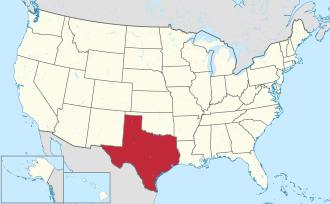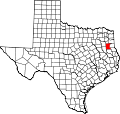History
Prior to Texas' annexation in 1845, the land while from time to time occupied by Caddoan peoples, was generally unpopulated until 1819, when Cherokee Indians, led by The Bowl settled in what is now Rusk County. [3] The Treaty of Bowles Village on February 23, 1836, between the Republic of Texas and the Cherokee and 12 affiliated tribes, gave parts of western Rusk County along with parts of today's Gregg and Van Zandt Counties, in addition to the whole areas of Cherokee and Smith Counties to the tribes. [4] They remained on these lands until the Cherokee War in the summer of 1839. Thus the Cherokee were driven out of Rusk County only to return in 1844 and 1845 with the purchase of 10,000 acres of land by Benjamin Franklin Thompson a white man married to a Cherokee. This established the Mount Tabor Indian Community, [5] some six miles south of present-day Kilgore that later spread to incorporate areas near Troup, Arp and Overton, Texas. Originally organized as a part of Nacogdoches County, Rusk was established as its own county by the Congress of the Republic of Texas on January 16, 1843. By 1850, it was the second-most populous county in Texas of the 78 counties that had been organized at that time, according to the 1850 census. Rusk County's population was 8,148 then; it was surpassed only by Harrison County with 11,822 people.
With the discovery of oil in Joinerville, within the county, in October 1930, an oil boom began that caused county population to nearly double during the next decade, and caused dramatic changes in the county towns. Rusk is one of the five counties that are part of the East Texas Oil Field, whose production has been a major part of the economy since that time. [6]
Rusk County was one of 25 entirely dry counties in Texas until January 2012. The city of Henderson at that time opted to allow selling and serving beer and wine. [7]
America's worst school disaster happened in Rusk County in 1937, when nearly 300 people, most of them children, were killed in a natural gas explosion at the London Independent School District (which has since consolidated into West Rusk County Consolidated Independent School District).
Demographics
Historical population| Census | Pop. | Note | %± |
|---|
| 1850 | 8,148 | | — |
|---|
| 1860 | 15,803 | | 93.9% |
|---|
| 1870 | 16,916 | | 7.0% |
|---|
| 1880 | 18,986 | | 12.2% |
|---|
| 1890 | 18,559 | | −2.2% |
|---|
| 1900 | 26,099 | | 40.6% |
|---|
| 1910 | 26,946 | | 3.2% |
|---|
| 1920 | 31,689 | | 17.6% |
|---|
| 1930 | 32,484 | | 2.5% |
|---|
| 1940 | 51,023 | | 57.1% |
|---|
| 1950 | 42,348 | | −17.0% |
|---|
| 1960 | 36,421 | | −14.0% |
|---|
| 1970 | 34,102 | | −6.4% |
|---|
| 1980 | 41,382 | | 21.3% |
|---|
| 1990 | 43,735 | | 5.7% |
|---|
| 2000 | 47,372 | | 8.3% |
|---|
| 2010 | 53,330 | | 12.6% |
|---|
| 2020 | 52,214 | | −2.1% |
|---|
|
Rusk County, Texas – Racial and ethnic composition
Note: the US Census treats Hispanic/Latino as an ethnic category. This table excludes Latinos from the racial categories and assigns them to a separate category. Hispanics/Latinos may be of any race.| Race / Ethnicity (NH = Non-Hispanic) | Pop 2000 [13] | Pop 2010 [11] | Pop 2020 [12] | % 2000 | % 2010 | % 2020 |
|---|
| White alone (NH) | 17,564 | 35,237 | 32,022 | 69.63% | 66.07% | 61.33% |
| Black or African American alone (NH) | 4,881 | 9,359 | 8,240 | 19.35% | 17.55% | 15.78% |
| Native American or Alaska Native alone (NH) | 75 | 199 | 195 | 0.30% | 0.37% | 0.37% |
| Asian alone (NH) | 57 | 203 | 231 | 0.23% | 0.38% | 0.44% |
| Pacific Islander alone (NH) | 3 | 14 | 18 | 0.01% | 0.03% | 0.03% |
| Other Race alone (NH) | 14 | 50 | 162 | 0.06% | 0.09% | 0.31% |
| Mixed Race or Multiracial (NH) | 141 | 659 | 1,767 | 0.56% | 1.24% | 3.38% |
| Hispanic or Latino (any race) | 2,489 | 7,609 | 9,579 | 9.87% | 14.27% | 18.35% |
| Total | 25,224 | 53,330 | 52,214 | 100.00% | 100.00% | 100.00% |
According to the 2000 census, 47,372 people, 17,364 households, and 12,727 families resided in the county. [14] The population density was 51 people per square mile (20 people/km2). The 19,867 housing units averaged 22 units per square mile (8.5/km2). The racial makeup of the county was 74.89% White, 19.21% Black or African American, 0.35% Native American, 0.24% Asian, 0.01% Pacific Islander, 4.22% from other races, and 1.09% from two or more races. About 8.44% of the population was Hispanic or Latino of any race. In 2020, its population was 52,214. [12]
Of the 17,364 households, 32.50% had children under the age of 18 living with them, 58.20% were married couples living together, 11.20% had a female householder with no husband present, and 26.70% were not families. About 24.20% of all households was made up of individuals, and 12.90% had someone living alone who was 65 years of age or older. The average household size was 2.57 and the average family size was 3.05.
In the county, the population was distributed as 24.90% under the age of 18, 8.30% from 18 to 24, 27.80% from 25 to 44, 23.30% from 45 to 64, and 15.60% who were 65 years of age or older. The median age was 38 years. For every 100 females, there were 104.00 males. For every 100 females age 18 and over, there were 103.10 males.
The median income for a household in the county was $32,898, and for a family was $39,185. Males had a median income of $30,956 versus $19,749 for females. The per capita income for the county was $16,674. About 10.90% of families and 14.60% of the population were below the poverty line, including 20.80% of those under age 18 and 13.00% of those age 65 or over.
Rusk County is home to three privately run facilities for state prisoners: the East Texas Multi-Use Facility for treatment of state inmates, privately operated by the Management and Training Corporation; the Bradshaw State Jail, also private, placed in idle status as of August 2020 because of declining populations; [15] and the Billy Moore Correctional Center, also privately run by MTC. [16]
This page is based on this
Wikipedia article Text is available under the
CC BY-SA 4.0 license; additional terms may apply.
Images, videos and audio are available under their respective licenses.






